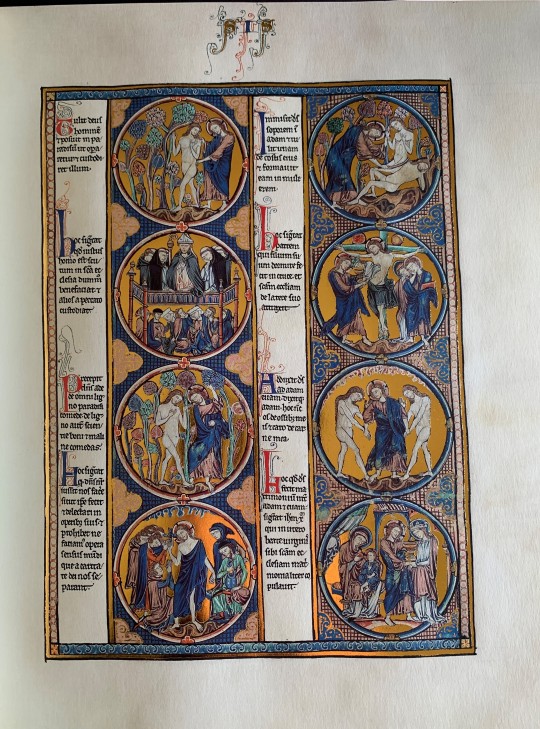#medievalstudies
This post was written by Charlie Taylor, a recipient of an Archival Scholar Research Award for the 2021 Spring Semester.
As part of my ASRA research, I’ve explored medieval illuminated manuscripts commissioned by queens of France, including this volume commissioned by Blanche of Castile. Blanche’s husband, Louis VIII of France, died when his heir was just 12 years old, and Blanche served as regent until Louis IX was old enough to take the throne. During her regency, which lasted from 1226 to 1234, she commissioned the Biblia de San Luis. The book is structured as a Bible moralisée, or moralized bible, intended to educate a young Louis on Christian doctrine and proper kingship.

(Above) Excerpt from 2001 reproduction of Biblia de San Luis.
The page pictured above comes from a facsimile — a close reproduction made for scholarly purposes — of the Biblia de San Luisin Pitt’s Frick Fine Arts Library. The page contains two columns of text accompanied by illustrations, some of which depict scenes from the book of Genesis: at top left, God strolls with Adam in the Garden of Eden; at top right, God removes a rib from Adam to create Eve.
However, not every illustration shows a scene from Genesis. If we look again at the top right, immediately below the creation of Eve, we see Christ on the cross, with a figure emerging from a wound in his chest. What is Jesus doing in the book of Genesis? Why does explicitly Christian imagery appear on this page, when the life of Christ occurred centuries after the Hebrew Bible was written? Why does God have a cruciform halo — a halo containing the image of a cross?
Bibles moralisées don’t contain the entire text of the bible front to back; rather, they take stories from the bible and provide commentary on them, explaining their relationship to Christian doctrine. In the Biblia de San Luis, each roundel forms a pair with the one immediately below it, with the first scene taken from the bible and the second offering commentary.
It is important to note that the commentary in this bible represents a Christian-centric worldview and often dismisses Jewish readings of the text. TheBiblia de San Luis treats the events of the Hebrew Bible as natural precursors to the events of the Christian Bible. Typology, as a form of commentary, takes certain events to foreshadow other events; this book asserts a typology in the creation of Eve and the creation of the Christian Church. In the second roundel, Ecclesia, a personification of the Church, emerges from Christ’s chest. The accompanying text explains that the scene from Genesis, in which God puts Adam to sleep and makes Eve from his rib, signifies God putting Christ to rest on the cross and pulling the Church from his side. Here, Christian doctrine (and the Church as an institution) becomes central to understanding the book of Genesis, pushing the story’s Jewish origins to the margins.
Works cited
William of Auvernge and Ramón Gonzálvez Ruiz. Biblia de San Luis. Barcelona: M. Moleiro, 2001.
Ferrante, Joan. “Blanche of Castile, Queen of France.” Epistolae, 2014. https://epistolae.ctl.columbia.edu/woman/77.html.
